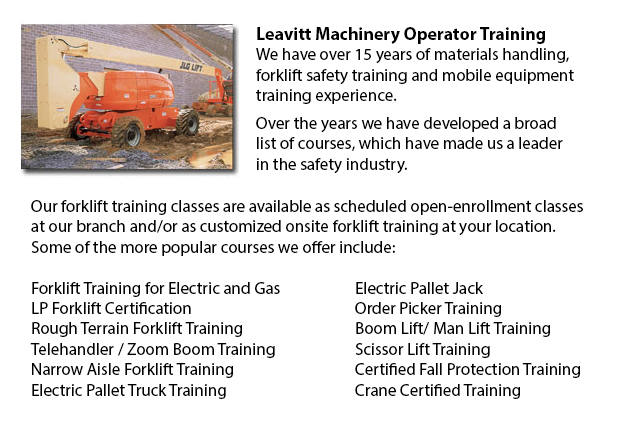
Toronto Boom Lift Certification - Elevated work platforms allow work and maintenance operations to be done at heights that can not be reached by any other way. Workers using scissor lifts and boom lifts could learn the safe operation of these devices by receiving boom lift certification training.
Despite the range in lift style, applications and site conditions, all lifts have the possibility for serious injury or death when not safely operated. Falls, electrocution, tip-overs and crushed body parts could be the tragic outcome of incorrect operating procedures.
To avoid aerial lift accidents, individuals have to be qualified to be able to train workers in the operation of the particular kind of aerial lift they would be using. Controls must be easily accessible in or beside the platform of boom lifts made use of for carrying workers. Aerial lifts must not be be altered without the express permission of the manufacturer or other recognized entity. If you are leasing a lift, make certain that it is properly maintained. Before utilizing, controls and safety devices need to be inspected in order to ensure they are correctly functioning.
It is important to follow safe operating procedures to be able to prevent workplace accidents. Driving an aerial lift while the lift is extended must not be carried out, nonetheless, a few models are designed to be driven when the lift is extended. Set outriggers, if available. Always set brakes. Avoid slopes, but when necessary make use of wheel chocks on slopes that do not exceed the slope limitations of the manufacturer. Follow manufacturer's load and weight limitations. When standing on the boom lift's platform, make use of a safety belt with a two-foot lanyard tied to the boom or basket or a full-body harness. Fall protection is not required for scissor lifts which have guardrails. Do not sit or climb on guardrails.
This course features the following topics: training and certification; safety tips to be able to prevent a tip-over; surface conditions and slopes; checking the work area & travel path; other guidelines for maintaining stability; stability factors; leverage; weight capacity; pre-operational inspection; testing control functions; safe operating practices; mounting a vehicle; safe driving procedures; overhead obstacles and power lines; PPE and fall protection; utilizing harnesses and lanyards; and avoid falling from the platform.
When successful, the trained worker will know the following: authorization and training procedures; pre-operational inspection procedures; factors affecting the stability of boom and scissor lifts; how to prevent tip-overs; how to use PPE, how to utilize the testing control functions and fall prevention strategies.
-
Toronto Wheel Loader Training
Toronto Wheel Loader Training - Normally, the different kinds of heavy equipment training are classed into 2 categories of machinery: those that have rubber tires and tracked vehicles. Tracked vehicles consist of items like for example excavators, cr... More -
Toronto Heavy Equipment Operator Training
Toronto Heavy Equipment Operator Training - Heavy equipment operator training facilities that provide good standards in the business, providing field performance tasks and added machinery training are really sought after training features. Students a... More -
Toronto Manlift Operator Certification
Toronto Manlift Operator Certification - We provide an aerial lift and scissor platform certification and training to empower the trainee with the general understanding and knowledge of the safe and efficient use of "Power Operated Mobile Work Platfo... More -
Toronto Aerial Boom Lift Ticket
Toronto Aerial Boom Lift Ticket - Aerial lifts can be utilized to accomplish a lot of unique duties done in hard to reach aerial spaces. Some of the odd jobs associated with this type of jack include performing regular preservation on structures with... More -
Toronto Heavy Equipment License
Toronto Heavy Equipment License - Obtaining a heavy equipment license is mandatory in order to operate these big industrial machinery. Certification could be acquired through a vocational school or private training. The license would enable the drive... More -
Skid Steer Loader Training in Toronto
A skid-steer loader is an engine powered equipment which consists of a small and rigid frame. It is outfitted together with lift arms that are utilized to connect to a large variety of labor saving tools and attachments. Typically, skid-steer loaders... More -
Toronto Aerial Lift Certification
Toronto Aerial Lift Certification - Aerial Lift Certification is for individuals who requires an in-depth understanding of aerial lift safety. Inspectors and operators, supervisors, maintenance workers and construction craftsmen should perform a cert... More -
Toronto Boom Lift Training
Toronto Boom Lift Training - Elevated work platforms, also called aerial platforms, allow workers to carry out tasks at heights which would otherwise be not reachable. There are different kinds of lifts intended for various site conditions and applic... More

Forklift Certification Toronto
TOLL FREE: 1-888-254-6157
Toronto, Ontario
forkliftcertificationtoronto.com
Email Us
About Us


